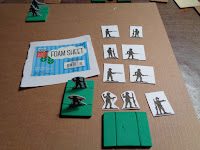Despite unexpectedly learning my printer can not handle 110 pound paper, but inspired by
another approach to basing Paper Soldiers by Kaptain Kobold, I decided to experiment with a foam approach to basing Paper Soldiers. I glue together 2 separate sheets of colored foam (different colored foam can be used to delineate armies). Let dry over night and then cut into 40 mm by 30 mm bases using a pair of scissors. Next, I use an Exacto knife to carefully cut through 1 layer of foam. For bases with 2 figures I mark and cut 10 mm from each end. For bases with 3 figures (machine guns, etc.), a third slice is made in the middle. If you are using 1 figure platoon HQ bases, they are 20 mm X 30 mm and have a single slice in the middle of the base. A 2 cut base is used for a Company HQ (Lt. and Sgt.). Tacky glue can be used to secure paper figures, but is NOT necessary.
Half of a Hand Bomber section
I am making a legendary American 369th Infantry (
"Harlem Hellfighters") platoon/company supported with French machine guns and led by French officers.
To print out your own WW I soldiers check out
Ungern's or Vasily Zaitzev's paper figures at World War I Ground Forces on the Junior General's website.
Inexpensive Platoon/Company level rules:
Trench Hammer rules (currently for under $5.00)
Unfortunately, Trench Hammer rules only include platoon information for the British and Germans.
US WW I platoon was made up of 4 sections: Hand Bombers, Rifle Grenadiers, Riflemen and Automatic Riflemen. Platoon HQ was 1 Lt., 1 Sgt. and 4 Privates.
French WW I platoon was also 4 sections (squads): Bombers (8 rifles), MG squad (1 chauchat, 6 rifles), 2 X rifle squads (12 rifles each).
I used 67 pound paper (on sale), but 65# (shinier paper) would be fine also. The glue for assembling the paper soldiers is Scotch Clear Glue.


